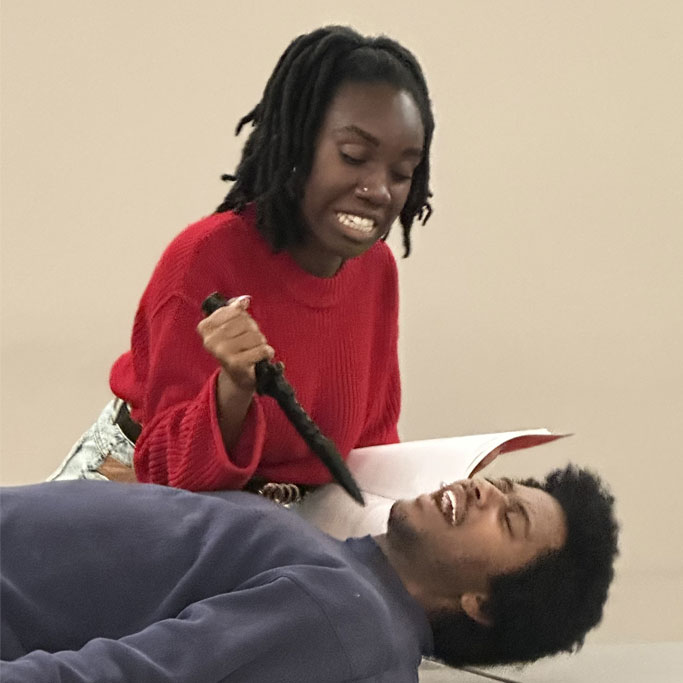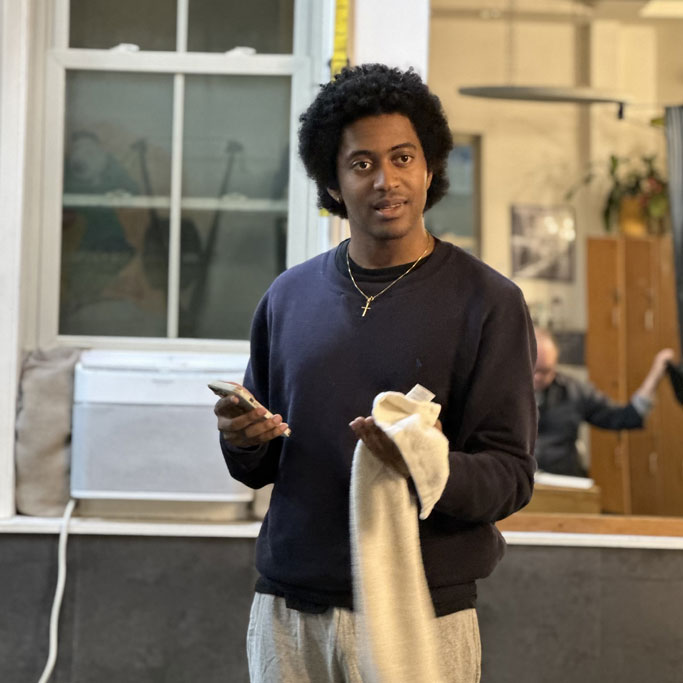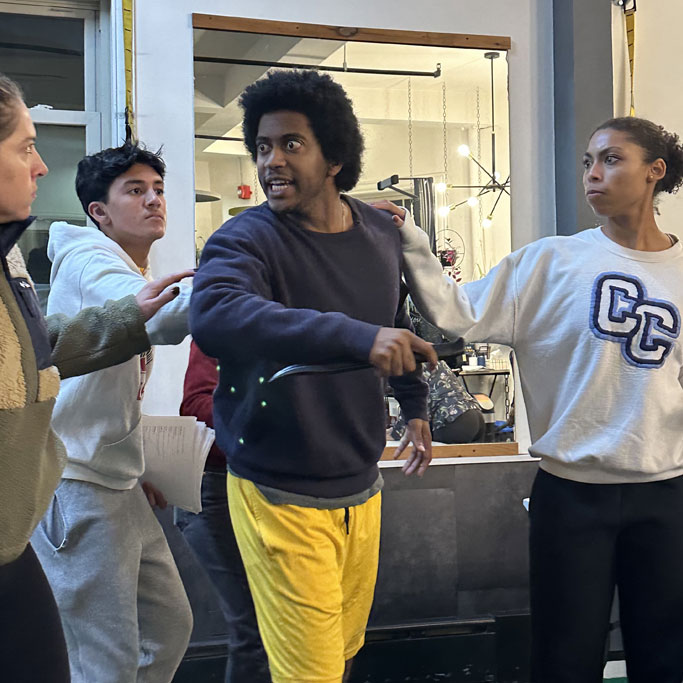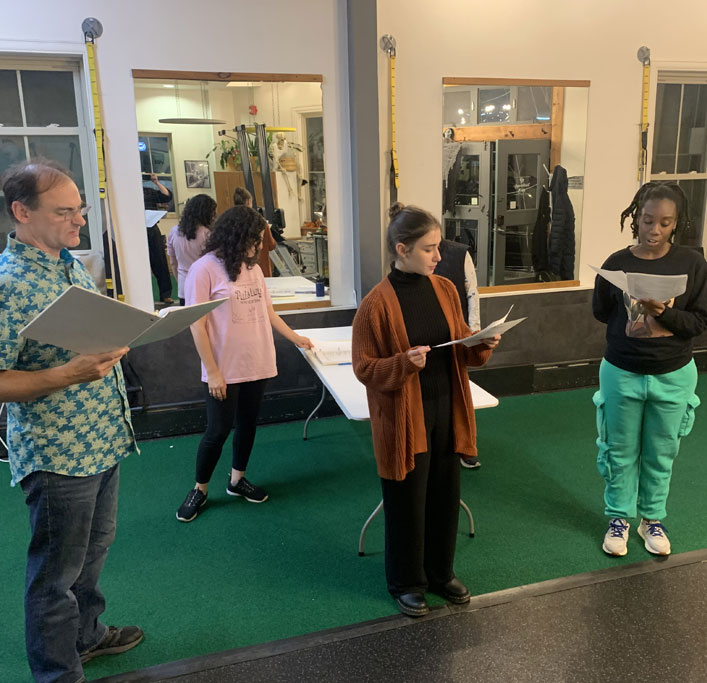
OTHELLO Study Guide
Welcome
Welcome to Anywhere Theatre Company’s production of OTHELLO by William Shakespeare!
In the Anywhere production, Othello, usually portrayed as a man, is a black female general, praised for her tactical expertise and aggression on the battlefield. Othello wins wars overseas, but her usefulness to the State ends at the water’s edge: back at home she is seen as an outsider and is shunned by society. When Othello secretly marries Desdemona, the daughter of a powerful but bigoted Senator, this gap widens even more.
Othello and Desdemona hope to create a world for themselves free of prejudice and hatred.But Iago, Othello’s most trusted aide, burns with a hidden love/hatred for Othello that sets this tragedy of jealousy, rage, race and politics into breathtaking motion.
Set in the middle of an endless, nameless war, Othello is a searing exploration of race, gender and sexual orientation in today’s society. In Othello, Shakespeare’s powerful language and unforgettable characters give us a map of where we’ve been, where we are today and where, if we set aside hatred and bigotry, we can go in the future.
Although it was written more than 400 years ago, Othello brings up questions about prejudice, love, jealousy and the destructive power of lies that are still very relevant today.
Othello brings up important questions like –
- “Why do we fall in love? What does it feel like to be in love?”
- “What makes us jealous? How do we feel when we’re jealous?”
- “Why are some people treated like outsiders in society? How does it feel to be an outsider?”
- “Why do we believe lies and misinformation?”
Shakespeare asks these questions and more but doesn’t wrap up the ending in a neat bow! Most of the questions he raises are left unanswered – Shakespeare leaves it to US to answer them for ourselves.
We hope you enjoy our production and use the exercises and lesson plans in this study guide to really dig into and explore these questions and this powerful play.
See you Anywhere!
The Anywhere Theatre Team
About Othello
Shakespeare wrote Othello between 1602 and 1604; like most of his plays, he stole, uh, adapted Othello’s plot from another source: a short novel by the Italian writer called The Moorish Captain.
Much of Shakespeare’s life and how he worked is shrouded in mystery, but for whatever reason, not for Othello: we have records of the play being performed at all of the major theatres in London and even at the wedding of King James’ daughter, Elizabeth (a little strange to perform this play at a wedding, if you ask us!)
Like all plays produced during Shakespeare’s life, Othello was originally performed with an all-male cast, with young men playing the female roles. This continued until King Charles II said it was okay for women to act on the stage. In 1660 Margaret Hughes played Desdemona, marking the first recorded performance of a woman acting on the English stage.
The character of Othello has been played by actors such as Laurence Olivier, OrsonWelles, Ben Kingsley, Anthony Hopkins, John Gielgud, Richard Burton and PatrickStewart: white actors using the infamous blackface style of makeup (except for PatrickStewart – he played Othello as the only white actor in a company of black actors in theShakespeare Theatre production in 1997). It wasn’t until 1825 that Ira Aldredge becamethe first Black actor to play the role on a professional stage. Since then, amazing actorssuch as Paul Robeson, Denzel Washington, Chiwetel Ejiofor, Laurence Fishburne,Lenny Henry, James Earl Jones, Eamon Walker and Avery Brooks have taken on therole.
And what about women playing Othello, as we do with our production? Women have always played the famous Shakespeare roles originally written for men, from Sarah Bernhardt playing Hamlet in 1899, Diane Venora playing Hamlet in 1982, Fiona Shaw (Aunt Petunia from the Harry Potter movies!) playing Richard II in 1995, Katherine Hunter playing Richard III in 2003 and many others. Jessika D. Williams and Deborah Anne Byrd both played Othello.
MEET THE CAST
Peter Royston (Director) We’ve always been told that the definition of “Tragedy” has to do withfinding the “flaw” of the main character like finding the final piece to a puzzle, and once youfind that missing piece, your job is done. You’re supposed to leave the theatre, or put down thebook, and say “Well, all I have to do is avoid that flaw, that fatal flaw, and then I can live ahappy life!” But of course, tragedy is not that easy. What I’ve learned while rehearsing this playis that tragedy was Shakespeare’s way of deeply exploring the human condition. Characterslike King Lear, Macbeth or Othello reveal themselves to us; they show us every range ofemotion and feeling – from the heroic and bold to the ugly and frightening – and we arebrought along for the ride. We share the character’s inner journey because we have walkedthat same road many times. At the end of a tragedy, questions remain unanswered – it’s up tous to take the questions home, to live them just as Othello does.

Caturah Brown
(Othello)
Describe your character
“Othello is a soldier that has only experienced violence and despair in her lifetime. She has never experienced love or probably never had a true friend.” …

Emma Freeman
(Desdemona)
Describe your character
“Desdemona is loving, steadfast, caring, sweet, and strong – I admire her ability to stay strong in the face of suffering, always choosing love and never acting cruel or changing who she is and what she believes.” …

Patrick Saint Ange
(Iago)
Describe your character
“Iago is a cunning and driven soldier who loves to outsmart people.” …

David Neilsen
(Brabantio)
Describe your character
“I am playing Brabantio, the father of Desdemona. Brabantio is a conservative politician who is scandalized by his daughter’s relationship with Othello.” …

Pam Davis
(Emilia)
Describe your character
“Emilia is dedicated and strong but beholden to a husband for whom she has little affection or respect. It’s difficult to understand why she would ever believe that giving her husband Desdemona’s handkerchief would lead to anything by mischief. She demonstrates foolishness when she gives Iago the handkerchief, but extreme bravery when she calls him and Othello out for their choices.“

Nick Nazario
(Cassio)

Courteney Cuomo
(Lodovico)

Isabella Moncado
(Duke of Venice)

Alyrae Ayala
(Bianca)

Brielle Blood
(Montano)

Anne Yanisko
(Soldier, Senator)
Not Pictured
- Will Royston (Roderigo)
- Kieran Raghavan (Gratiano)
- Kanishk Sharma (Soldier, Senator)
Rehearsal Shots








Lesson PLAN: The Outsider
Grade Level: 10-12
Subject: English Literature / Drama
Objectives:
- Analyze the character of Othello as an outsider in society.
- Understand how the theme of the outsider influences the plot and character dynamics in Othello.
- Discuss the social implications of being an outsider in the context of race, status, and sexual identity.
- Develop critical thinking and argumentative skills through discussion and writing.
Materials:
- Copies of Othello (text or online access)
- Whiteboard and markers
- Projector (for clips or visuals)
- Handouts with key quotes and themes
- Access to articles or essays about the themes in Othello
Activities:
Day 1: Introduction to Othello and the Concept of the Outsider
- Warm-up Discussion (15 minutes):
- Ask students: “What does it mean to be an outsider?”
- Discuss their thoughts and examples from modern contexts. How has the role of the outsider changed throughout history? Who are the outsiders today?
- Introduction to Othello (20 minutes):
- Provide a brief overview of the play’s plot and characters.
- Discuss the differences between the play version of Othello and the Anywhere Theatre version. From the script version, highlight Othello's background as a Moor and how this affects his position in Venetian society. Thinking about the Anywhere version, discuss Othello’s background as a woman general and as a lesbian. How do these different versions affect the overall play?
- Reading Assignment (25 minutes):
- Read Act 1, Scene 1 aloud in class.
- Assign roles for students to take turns reading. Discuss initial reactions to Othello as an outsider. Note lines that delineate Othello as an outsider. How do lines from others mark Othello as an outsider? How do lines that Othello says about herself mark her as an outsider?
Day 2: Character Analysis and Themes
- Character Focus (30 minutes):
- Divide students into groups to analyze the following characters:
– Othello
– Iago
– Desdemona
– Cassio - Each group should explore how these characters perceive Othello and how this shapes their actions. Again, discuss the differences between the script version and the Anywhere Theatre version.
- Divide students into groups to analyze the following characters:
- Class Discussion (20 minutes):
- Groups share their insights. Focus on themes of jealousy, betrayal, and societal perception of Othello.
- Discuss how Othello’s identity as an outsider influences her decisions and relationships.
- Homework:
- Write a short reflection (1 page) on how Othello’s status as an outsider impacts her fate. Be sure to cite examples from the script and the Anywhere production.
Day 3: Creative Response and Final Reflection
- Creative Project (30 minutes):
- Students create a modern adaptation of a scene where they reinterpret Othello’s outsider status. This could be in the form of a skit, a poem, or a visual artwork.
- Presentations (20 minutes):
- Groups present their adaptations to the class.
- Encourage them to explain how their work reflects themes from the play.
- Final Reflection (10 minutes):
- Conclude with a discussion on the relevance of Othello today.
- Assign a final essay: “How does Shakespeare portray the role of the outsider in Othello, and what can we learn from it in contemporary society?”
Assessment:
- Participation in discussions and group work.
- Written reflection on Othello’s status as an outsider.
- Evaluation of creative project and presentation.
- Final essay assessing understanding of themes.
Standards:
English Language Arts Standards:
- CCSS.ELA-LITERACY.RL.11-12.1: Cite strong and thorough textual evidence.
- CCSS.ELA-LITERACY.RL.11-12.2: Determine a theme or central idea.
- CCSS.ELA-LITERACY.SL.11-12.1: Initiate and participate effectively in a range of collaborative discussions.
Theatre Standards:
- TH.1.HS.P1: Generate and conceptualize artistic ideas and work.
- TH.1.HS.P2: Analyze and interpret artistic work.
- TH.1.HS.P2: Apply criteria to evaluate artistic work.
Lesson PLAN: Trust
Theatre Exercise: “Trust in Silence”
The play Othello is all about trust – once Othello loses trust in the ones she loves through Iago’s lies and misinformation, she is completely lost and untethered – she becomes almost mad in her anger and isolation. This exercise will explore the nature of trust.
Objective: To explore the concept of trust through non-verbal communication and collaboration.
Duration: 30-45 minutes
Group Size: 6-12 participants
Setup:
- Space: A clear, open area where participants can move freely without distractions.
- Materials: A blindfold (optional).
Instructions:
- Warm-Up (5-10 minutes):
- Start with a brief physical warm-up to get everyone relaxed. Simple stretches and breathing exercises work well.
- Pairing Up (5 minutes):
- Divide the group into pairs. If the group is odd, one trio can be formed.
- Have each pair discuss and share something they trust about each other (this can be light-hearted or meaningful).
- Silent Movement (15 minutes):
- One partner in each pair will be blindfolded (or simply close their eyes).
- The sighted partner will guide the blindfolded partner around the space using only non-verbal cues (gentle touches on the shoulder, guiding with a hand, etc.).
- They should navigate obstacles and move around the area without speaking. The sighted partner should ensure the blindfolded partner feels safe and secure.
- Role Reversal (10 minutes):
- After about 5-7 minutes, have the partners switch roles. The previously blindfolded partner now guides while the other is blindfolded.
- Group Reflection (10 minutes):
- Gather everyone in a circle and discuss the experience.
- Prompts can include:
– How did it feel to trust someone completely in silence?
– What were some challenges in communication?
– How did you ensure the other person felt safe?
– What did you learn about trust through this exercise?
- Conclusion (5 minutes):
- Finish with a brief moment of gratitude where each participant shares one positive thing they took away from the exercise.
Notes:
- Emphasize the importance of communication beyond words and the power of physical presence.
- Encourage participants to respect each other’s boundaries and comfort levels throughout the exercise.
- Adjust the exercise based on the group dynamics and comfort levels.
- Why is trust such an important emotion when creating a work of theatre?
Lesson PLAN: Misinformation
The Role of Misinformation in Shakespeare’s Othello and Modern Society
Almost nowhere else in Shakespeare’s work does a character fall from such a great height. At the beginning of the play, Othello is introduced as perfect in every aspect: an extraordinary soldier and leader, a public speaker, a poet, a good friend, respectful, kind and a loving partner to Desdemona. But through the play, Othello is brought down by one thing: lies or what we call today “misinformation.” This is something that we deal with on a day-to-day basis today: how can we know whether the facts we are given are true, or lies?
Grade Level: 11-12
Subject: English Language Arts / Literature
Duration: 2 class periods (90 minutes each)
Objectives:
- Analyze the role of misinformation and deception in Othello.
- Discuss the impact of misinformation in contemporary society.
- Develop critical thinking and analytical writing skills.
- Connect themes in literature to real-world issues.
Standards:
- CCSS.ELA-LITERACY.RL.11-12.1: Cite strong textual evidence to support analysis.
- CCSS.ELA-LITERACY.RL.11-12.2: Determine a theme or central idea and analyze its development.
- CCSS.ELA-LITERACY.W.11-12.1: Write arguments to support claims in an analysis of substantive topics.
- CCSS.ELA-LITERACY.SL.11-12.1: Initiate and participate effectively in a range of collaborative discussions.
Materials:
- Copies of Othello (specific scenes highlighted)
- Articles on misinformation in modern society
- Whiteboard and markers
- Projector and screen for videos or presentations
- Writing materials
Day 1: Introduction to Misinformation in Othello
Warm-Up (15 minutes):
- Discussion Prompt: “What is misinformation?” Students write their definitions and share with a partner. Discuss as a class.
Direct Instruction (20 minutes):
- Introduce Othello and its main themes.
- Briefly discuss how misinformation plays a crucial role in the plot. Highlight key characters (Iago, Othello, Desdemona) and their relationships.
Textual Analysis (30 minutes):
- Group Activity: Divide students into small groups and assign each group a scene from Othello where misinformation is central (e.g., Act III, Scene 3 – the “handkerchief” scene).
- Groups will:
- Read their scene.
- Identify instances of misinformation and discuss the motivations behind these actions.
- Prepare a short presentation on their findings.
Day 2: Misinformation in Modern Society
Warm-Up (10 minutes):
- Quick write: “What did you learn about misinformation from the article?” Share insights with the class.
Comparative Analysis (30 minutes):
- Class Discussion: How do the mechanisms of misinformation in Othello compare to those in modern society? Use guiding questions:
- What methods do characters use to spread misinformation?
- How do similar techniques manifest today (social media, news, etc.)?
Critical Writing (30 minutes):
- Writing Prompt: “Analyze the role of misinformation in Othello and discuss its implications in today’s world. How can literature help us understand contemporary issues?”
- Students will write a 1-2 page essay responding to the prompt.
Closure (10 minutes):
- Students share their main points from their essays in small groups. Discuss the importance of critical thinking in assessing information both in literature and real life.
Assessment:
- Participation in discussions and group activities.
- Quality of group presentations.
- Essays will be evaluated based on clarity of argument, textual support, and connections to modern examples.
Extensions:
- Create a multimedia project exploring a recent case of misinformation in the news.
- Organize a debate on the effects of misinformation in society and its parallels in literature.
Lesson PLAN: Adaptation & Gender
Exploring Gender Roles through Character Adaptation
The Internet calls it “Rule 63”: the idea that for every character in fiction there’s agender-swapped counterpart. This has become a more and more popular trend: takingclassic stories and rewriting them with the main character or characters in anothergender. For our Anywhere production of Othello, we took the main character ofOthellok traditionally played by a man and as a man, and changed the story so Othellowas played as a modern woman general. How can the story change when the genderof the main character is changed?
Grade Level: 9-12
Subject: English Language Arts
Duration: 2-3 class periods (90-120 minutes total)
Lesson Objectives:
- Analyze how switching the gender of main characters in classic stories affects themes and character dynamics.
- Evaluate adaptations of classic literature to understand contemporary perspectives on gender roles.
- Create a short adaptation of a classic story with gender-swapped main characters.
Standards Alignment:
- CCSS.ELA-LITERACY.RL.9-10.1: Cite strong and thorough textual evidence to support analysis of what the text says explicitly as well as inferences drawn from the text.
- CCSS.ELA-LITERACY.RL.9-10.3: Analyze how authors use and refine literary elements (e.g., character, setting, conflict) to create meaning.
- CCSS.ELA-LITERACY.W.9-10.3: Write narratives to develop real or imagined experiences using effective technique, well-chosen details, and well-structured event sequences.
Materials:
- Excerpts from classic literature (e.g., “Romeo and Juliet,” “The Odyssey,” “Little Red Riding Hood”)
- Examples of gender-swapped adaptations (e.g., “The Tempest” with female Prospero (2010, dir Julie Taymor, starring Helen Mirren), Gender-Swapped Greek Myths by Karrie Fransmen and Jonathan Plackett, Gender-Swapped Fairy Tales by Karrie Fransmen and Jonathan Plackett)
- Whiteboard and markers
- Paper and writing utensils
Lesson Outline:
Day 1: Introduction and Analysis (45-60 minutes)
- Warm-Up Activity (10 minutes):
- Pose the question: “How do gender roles influence character actions and relationships in stories?”
- Students discuss in pairs and share their thoughts with the class.
- Direct Instruction (15 minutes):
- Introduce the concept of gender roles in literature.
- Discuss classic stories and their main characters, noting traditional gender portrayals.
- Introduce the examples of gender-swapped adaptations:
– “She’s the Man” (based on Shakespeare’s “Twelfth Night”)
– “The Tempest” with a female Prospero (modern adaptations)
– “Gender-Swapped Greek Myths by Karrie Fransmen and Jonathan Plackett
– “Gender-Swapped Fairy Tales” by Karrie Fransmen and Jonathan Plackett
- Group Activity (20-30 minutes):
- Divide students into small groups.
- Assign each group a classic story and provide them with excerpts.
- Each group will discuss how the story would change if the main character’s gender were switched, focusing on themes, character motivations, and relationships.
- Groups will share their insights with the class.
Day 2: Creation and Presentation (45-60 minutes)
- Writing Activity (30 minutes):
- Each student chooses a classic story and creates a short narrative story that features gender-swapped main characters.
- Encourage creativity and exploration of how the new gender dynamics influence the plot and themes.
- Presentation (15-30 minutes):
- Students share their adaptations with the class.
- Classmates can provide feedback focusing on how gender changes affected the story.
Assessment:
- Participation in discussions and group activities.
- Quality and creativity of the written adaptations.
- Ability to articulate the impact of gender-switching on character dynamics and themes during presentations.
Welcome to the POCANTICO CENTER

Once home to the Rockefeller family, The Pocantico Center’s verdant campus in the scenic hills of the Hudson Valley has been host to some of the most influential leaders, thinkers, and creative minds of the last century. Today, the Rockefeller Brothers Fund continues to bring together people at Pocantico through a robust slate of conferences, artist residencies, tours, performances, exhibitions, and educational programs.

